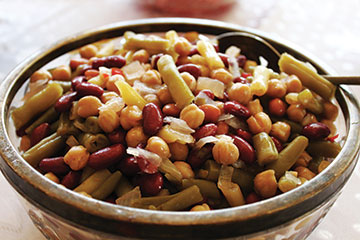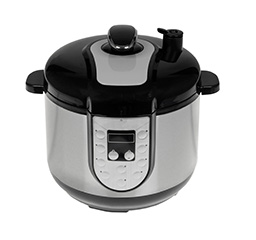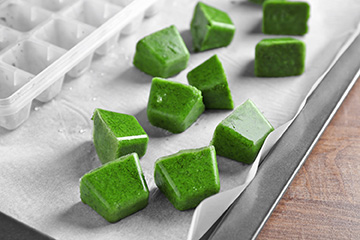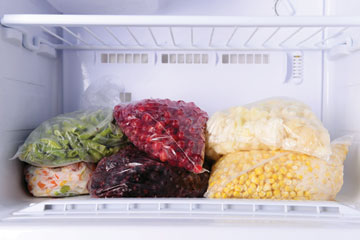Pickled Three-Bean Salad

- 1½ cups cut and blanched green or yellow beans (prepared as below)
- 1½ cups canned, drained, red kidney beans
- 1 cup canned, drained garbanzo beans
- ½ cup peeled and thinly sliced onion (about 1 medium onion)
- ½ cup trimmed and thinly sliced celery (1½ medium stalks)
- ½ cup sliced green peppers (½ medium pepper)
- ½ cup white vinegar (5 percent)
- ¼ cup bottled lemon juice
- ¾ cup sugar
- ¼ cup oil
- ½ teaspoon canning or pickling salt
- 1¼ cups water
Yield: About 5 to 6 half pints
Procedure: Wash and snap off ends of fresh beans. Cut or snap into 1- to 2-inch pieces. Blanch 3 minutes and cool immediately. Rinse kidney beans with tap water and drain again. Prepare and measure all other vegetables. Combine vinegar, lemon juice, sugar and water and bring to a boil. Remove from heat. Add oil and salt and mix well. Add beans, onions, celery and green pepper to solution, and bring to a simmer. Marinate 12 to 14 hours in refrigerator, then heat entire mixture to a boil. Fill clean jars with solids. Add hot liquid, leaving a half inch of headspace.
Adjust lids and process in half-pint or pint jars in a boiling water canner for 15 minutes at an altitude of 0–1000 feet, and for 20 minutes at an altitude of 1,001–6000 feet.
Source: National Center for Home Food Preservation. 2018. Preparing and canning relishes: Pickled three-bean salad.
Don’t Can in an Electric Pressure Cooker

Electric pressure cookers are a hot item. A top-five seller during the past holiday season, sales of electric “multicookers” have risen 79 percent in the last 18 months to more than $300 million, according to The NPD Group Inc., a market-research firm.
Fans of electric pressure cookers say they can perform many kitchen functions. But don’t plan to do pressure canning in one of these new appliances, cautions Elizabeth Andress, director of the National Center for Home Food Preservation (NCHFP) at the University of Georgia. The NCHFP was created in partnership with the U. S. Department of Agriculture (USDA) to make research-based recommendations for home food preservation, including home canning.
Even if the appliance includes a button or setting for “canning” or “steam canning,” the NCHFP does not support making USDA canning recipes in the new electric pressure cookers because not enough research has been done to prove their ability to can food safely. USDA guidelines were developed and tested for stovetop pressure canners that hold four or more quart-size jars, and have not been tested in smaller cookers.
“You can’t just assume that what works in a 16-quart stovetop pressure canner works in a small electric canner,” Andress said in a recent interview with CNET, a technology review website. Doing pressure canning in an electric pressure cooker that has not been verified for safely canning low-acid food is not a cooking function, but a public health issue, Andress said in the CNET article.
Of concern is the ability of the canning process to kill the spores of the Clostridium botulinum bacteria, which thrive in moist, low-acid environments in the absence of oxygen. The spores are very heat-resistant and can only be destroyed by the right combination of time and temperature. Spores that survive inadequate canning can cause botulism, a serious—and sometimes deadly—illness.
The National Center for Home Food Preservation does not recommend pressure canning with electric multicookers because not enough research has been done on key parts of the food preservation process in those appliances to determine their ability to safely preserve food. See the “Burning Issue: Canning in Electric Multi-Cookers” fact sheet at nchfp.uga.edu/publications/nchfp/factsheets/electric_cookers.html for more information on the research concerns with these small appliances. (No longer available online.) As an alternative, see Can I Can in a Multi-Cooker?.
For safe and reliable pressure canning of low-acid foods, avoid the new electric multicookers. Instead, choose a standard pressure canner that is large enough to hold at least four quart jars with a weighted or dial gauge to monitor the pressure.
Sources:
The NDP Group Inc. 2017. All I want for Christmas is a multi-cooker. News release, December 13. npd.com/wps/portal/npd/us/news/press-releases/2017/all-i-want-for-christmas-is-a-multi-cooker/. (No longer available online.)
CNET. 2018. The new Instant Pot Max has a canning feature. Is it safe? April 7.
What’s the Safest Method of Preserving Homemade Pesto?

Gardens are brimming with fresh herbs, especially basil! A tasty way of using basil is to make pesto, but is it safe to home can? NO! The National Center for Home Food Preservation does not recommend this process, but does have researched recommendations for freezing. You can freeze prepared pesto in small freezer containers or in ice cube trays (2 tablespoons per cube). Another option is to freeze pesto in a square pan, covered with plastic wrap. When completely frozen, cut the pesto into cubes and transfer them to a resealable plastic freezer bag. Frozen pesto will store for up to six months. Thaw pesto cubes for 15 minutes at room temperature or at 30-second intervals in a microwave oven until they’re soft. Mash with a fork before using the pesto in recipes.
So why can’t we home can? Herbs and oils are both low-acid, and together could support the growth of disease-causing Clostridium botulinum bacteria. Also, given the thickness of the mixture of basil, garlic, oil, pine nuts and cheese, there is a high risk that heat will not penetrate to the center of the jar as safe canning requires.
Spring Cleaning for Your Freezer

If you freeze garden produce in the summer and fall, spring is a great time to clean out your freezer to get ready to store the upcoming season’s harvest. If you have a manual-defrost freezer, you must defrost it at least once a year, or when there is more than a quarter inch of frost over a large area of the freezer surface. A frost-free freezer does not need defrosting, but it still should be cleaned once a year or more often if dirt or food residues are visible. To clean, turn off the power source (unplug), empty the freezer and wipe it with a cleaning solution of one tablespoon of baking soda per quart of water. Rinse it with a cloth dipped in clean water, towel it dry and replace the food. Use a refrigerator or freezer thermometer, and check it often to ensure that the freezer temperature stays at or below zero degrees F. Foods lose quality much more quickly at higher temperatures.
Frozen fruits and vegetables are best when used within eight to 12 months of storage at zero degrees F. After these times, the foods should be safe, though lower in quality. Place foods in the freezer into food groups for ease in locating, so you don’t forget the products you have in the freezer and can enjoy the fruits of your labor at their best quality.
Source: National Center for Home Food Preservation. n.d. How do I…freeze: General freezing information.
